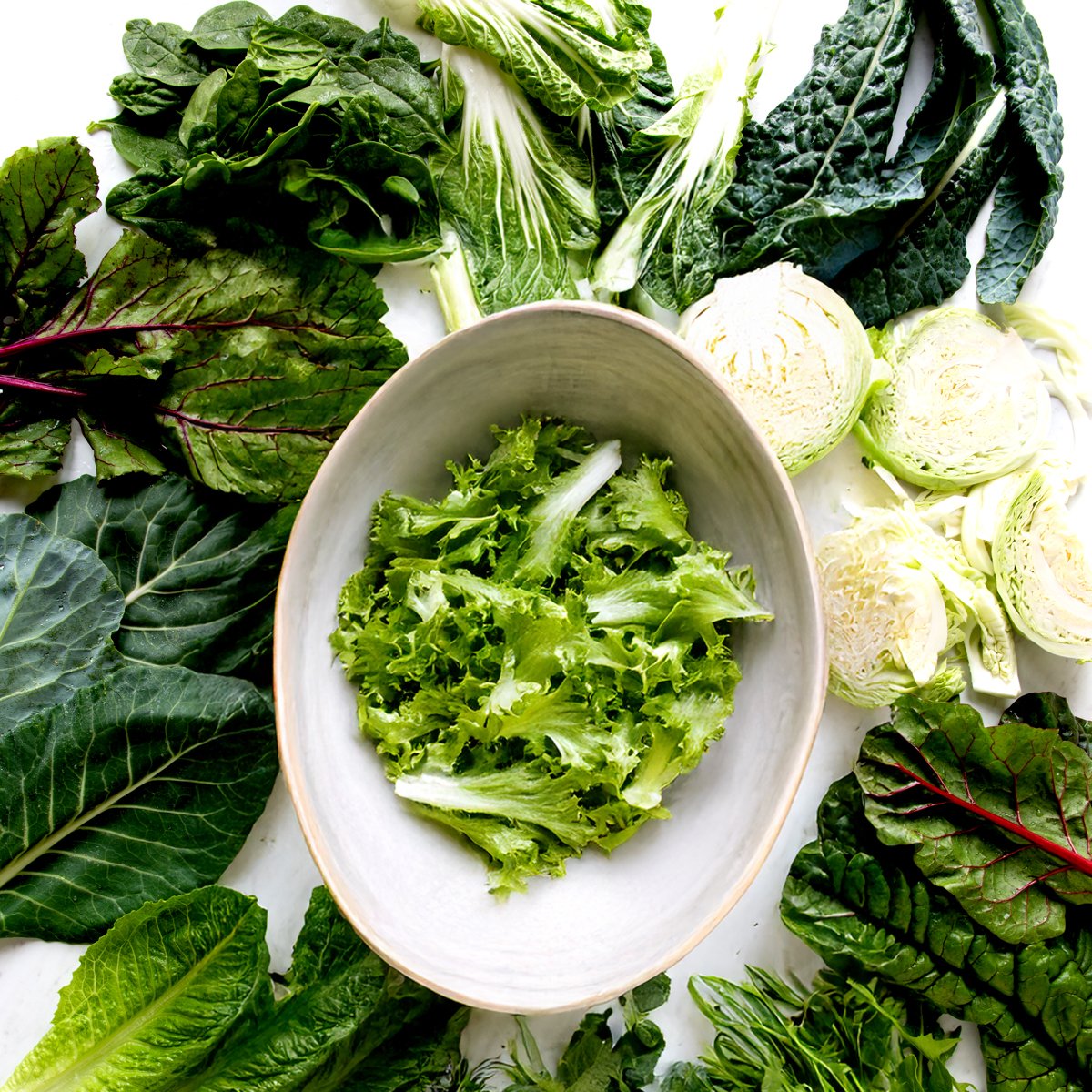
This post may contain affiliate links, meaning I can earn a small commission from items you purchase (at no cost to you).
Table of contents
Step aside salad. You’re no longer the only way to get leafy green vegetables into our diet. The following nutritional powerhouses deserve a starring role in any kitchen— not just for a trained chef. Packed with vitamins, minerals, and antioxidants, leafy greens offer a wealth of health benefits and surprising versatility in the kitchen.
I started my love affair of leafy greens with blending baby spinach into my smoothies. Over time, I started to crave more leafy green vegetables. From vibrant stir-fries to hearty plant-based soups and even delicious green smoothies, it’s time to look beyond the bowl and discover the exciting world of cooking and blending with leafy greens.
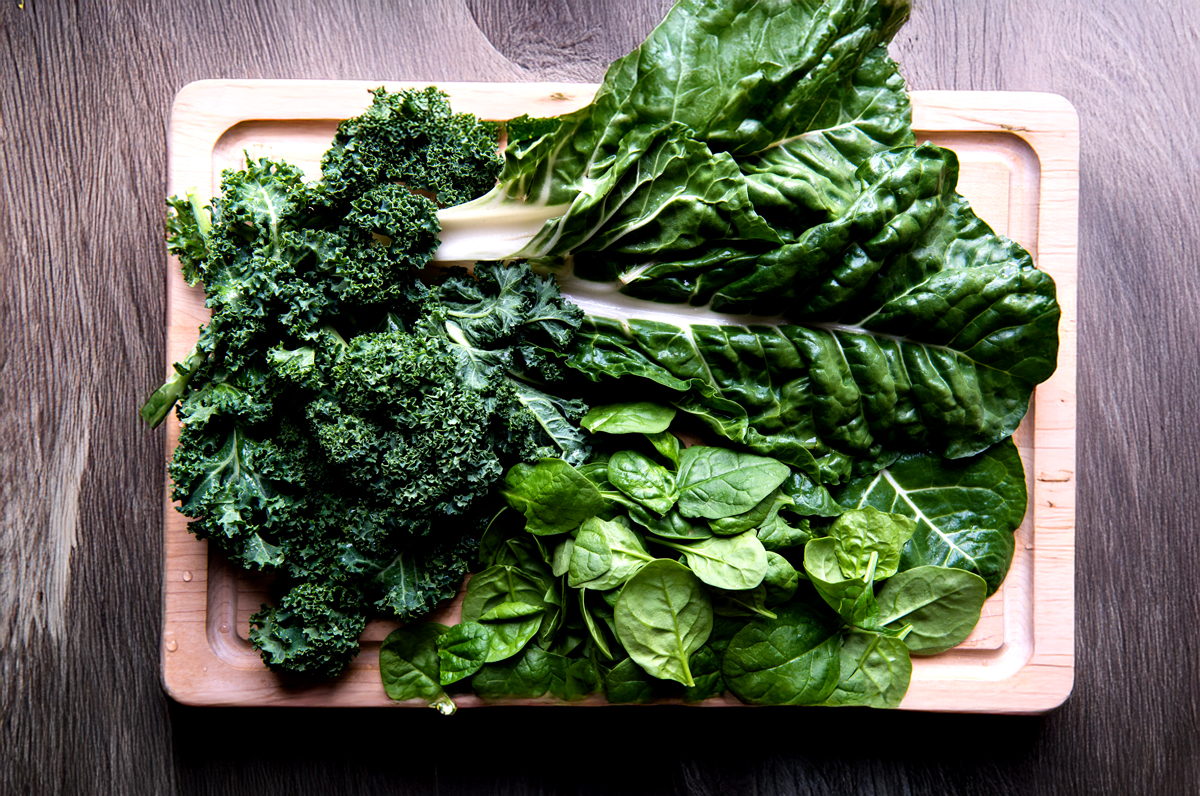
Health Benefits of Leafy Green Vegetables
Leafy greens are super important for a healthy diet. They’re nutrient-dense, green veggies that provide tons of vitamins and minerals. According to a report in the journal Neurology, a daily serving of leafy greens can lead to slower age-related cognitive decline. The term “leafy greens” encompasses a wide array of edible leaves, each with its unique flavor profile and texture. Getting familiar with the leafy green varieties is the first step to unlocking their culinary potential.
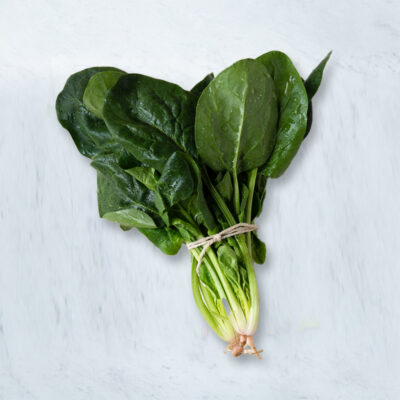
Spinach
Mild & slightly sweet
Spinach is a nutritional powerhouse, packed with vital vitamins (K, A, C), folate, and iron, crucial for bone health, vision, immunity, cell growth, and red blood cell production. Its high antioxidant content and plant compounds may also lower the risk of chronic diseases, making it a valuable addition to a healthy diet.
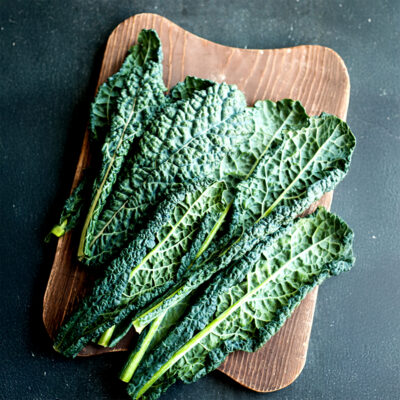
Kale
Hearty & slightly bitter
Kale has different varieties like curly kale, Lacinato (dinosaur) kale, and baby kale offer varying textures. With 684% of the recommended daily value of vitamin K, 206% of the RDV of vitamin A and 134% of the RDV of vitamin C, this dark leafy green packs a health punch.
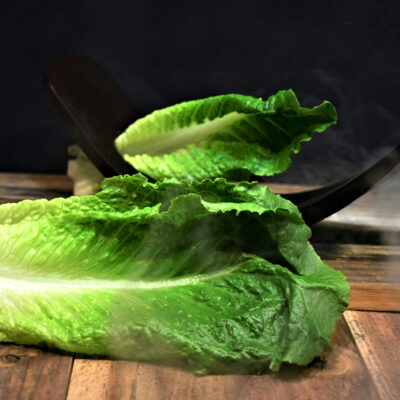
Lettuce (Romaine, Butter, Iceberg)
Mild & slightly sweet
Primarily used raw for salads and wraps, some firmer varieties like romaine can be lightly grilled or braised. Romaine lettuce is high in fiber and low in calories. The vitamin C and beta-carotene content help to lower cholesterol and prevent build-up on artery walls, which reduces the risk of a heart attack.
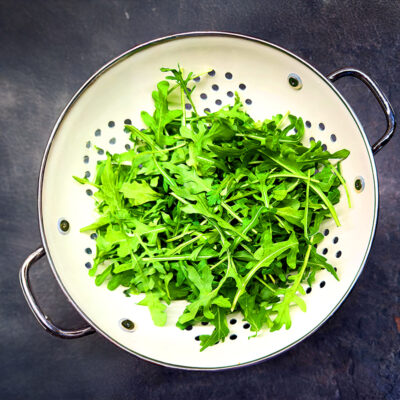
Arugula (Rocket)
Peppery & slightly bitter
Arugula adds a zesty kick to salads and cooked dishes. More than just a garnish, one cup of this leafy green contains 27.7% of the RDV of vitamin K. Tastes best on top of pizza, in a salad or sandwich. I don’t recommend making smoothies with it.
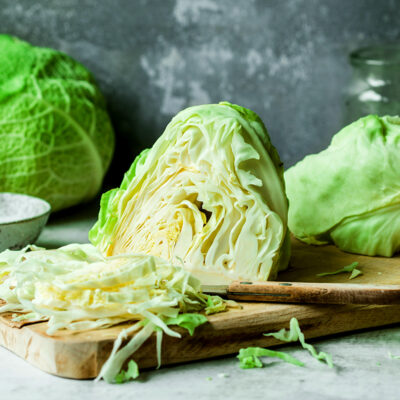
Cabbage
Hearty & pungent
This leafy green can actually be purple, red, white or green, but is definitely still considered a leafy green. I love using cabbage as a plant-based taco shell, blended in a cabbage smoothie or roasted cabbage with light seasoning. Loaded with fiber, folate, vitamin B6 and antioxidants which help fight inflammation.
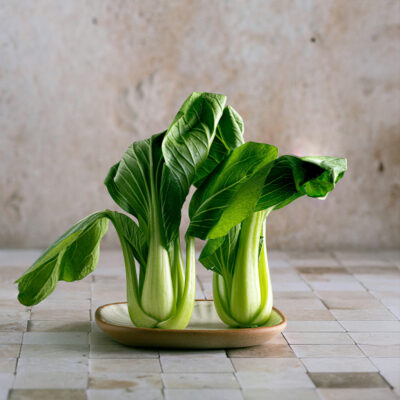
Bok Choy
Mild & slightly sweet
Bok choy is excellent stir-fried, steamed, or added to soups. Full of vitamins A and C, bok choy ranks high for nutrient density as well. All parts of the plant can be used: shredded in a salad, my vegetarian ramen, cooked in soup or blended in a smoothie.
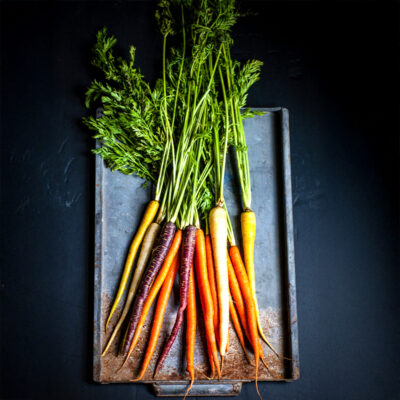
Carrot Greens
Herbaceous & slightly bitter
Carrot tops offer surprising nutrition, providing vitamin K for blood clotting and bones, vitamin C for immunity, and potassium for blood pressure regulation. Their phytonutrients also offer potential anti-inflammatory and antioxidant benefits, making them a worthwhile to smoothies or even pesto!
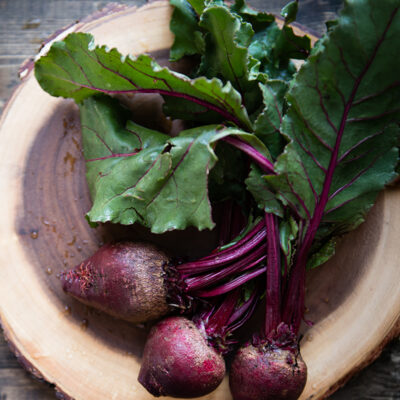
Beet Greens
Slightly earthy
Beet tops are a nutritious leafy green, rich in vitamins K and A, vital for blood clotting, bone health, vision, and immunity. High in phytonutrients, including betalains, beet greens have anti-inflammatory benefits. When blending smoothies with beets, wash and blend in the beet greens.
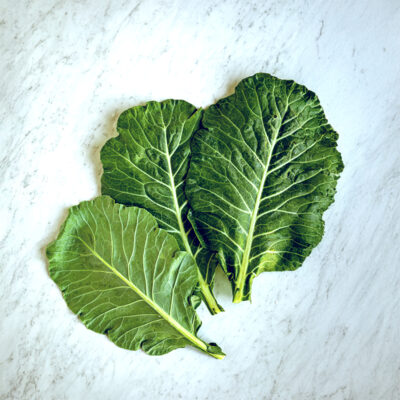
Collard Greens
Tough & slightly bitter
Collard greens benefit from long cooking times. Like their other cruciferous family members, collard greens are great cancer fighters. They are also pretty good at helping your body digest foods properly with all the fiber inside. They are most popular steamed, but adding them raw to your smoothies will provide greater health benefits.
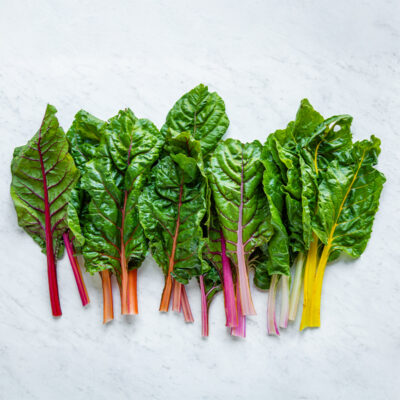
Swiss Chard
Mild & slightly earthy
Mild and slightly earthy with colorful stems that are also edible, Swiss chard is a beautiful and nutritious addition to many dishes. Chard is a colorful, dark leaf known for its ability to regulate the body’s blood sugar. Translation? If diabetes or maintaining blood sugar levels is a concern, add this veggie to your regular rotation.
Leafy Greens Recipes
5 Ways to Use Leafy Greens
Ready to move beyond the traditional salad? Here are some inspiring ways to incorporate more leafy greens into your daily meals:
- Sautéed and stir-fried: Spinach, baby kale, and Swiss chard wilt beautifully in a hot pan with a little olive oil, garlic, and a pinch of salt and pepper. A squeeze of lemon adds brightness. Heartier greens like kale, mustard greens, and bok choy hold up well in stir-fries. Add them towards the end of cooking to maintain some texture and vibrant color. Pair them with your favorite proteins, vegetables, and sauces.
- Soups for warmth and nutrition: Stir in chopped spinach, kale, or Swiss chard during the last few minutes of cooking vegetable soup recipes. They will wilt down and add a boost of nutrients and a touch of freshness. Blend cooked greens like spinach or kale with broth, sautéed onions, and a touch of cream or coconut milk for a smooth and nutritious soup.
- Baked delights with a green twist: Incorporate chopped leafy greens into egg-based dishes like quiches and frittatas. They add color, flavor, and valuable nutrients. Layer sautéed greens into pasta bakes and lasagnas for an extra dose of vegetables. They blend seamlessly with the other ingredients. Add finely chopped cooked greens to roasted root vegetables, or use them as a filling for savory pastries and dumplings.
- Blended goodness in smoothies: Don’t be afraid to toss a handful of spinach or kale into your breakfast smoothie. The flavor is surprisingly mild when combined with fruits, yogurt, and other ingredients.
- Creative raw preparations: While not technically a recipe, juicing leafy greens is a great way to consume a concentrated amount of nutrients. Blend arugula, spinach, or kale with nuts, garlic, olive oil, and lemon juice for a vibrant and flavorful pesto. You can also layer large lettuce leaves like romaine or butter lettuce to create healthy and delicious lettuce wraps and sandwiches.
Benefits of Rotating Leafy Greens
I often talk about rotating your greens when making green smoothies. This is because leafy greens come from all different plant families, each offering different health benefits. Yet if spinach is your jam, no worries! Keep doing that. You can always have a salad with kale or make a soup with Swiss chard.
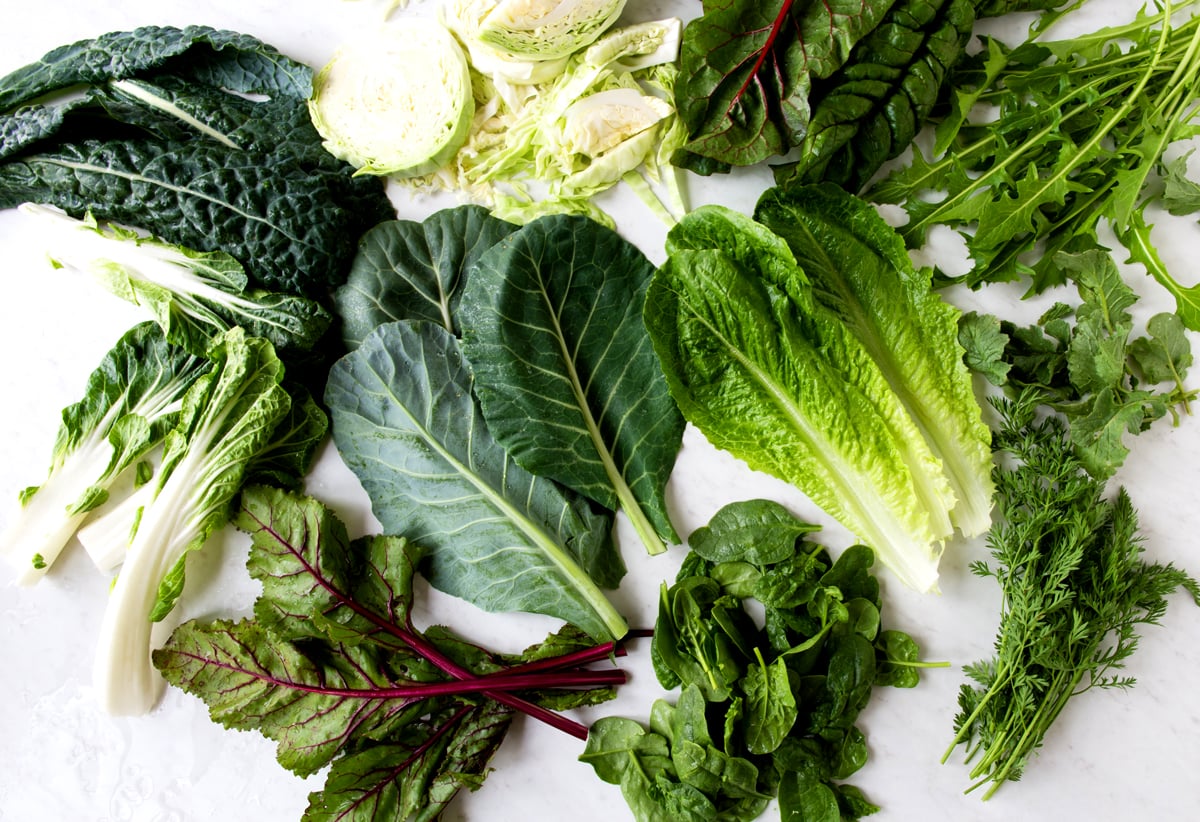
Tips for Cooking with Leafy Green Vegetables
Leafy greens are more than just a salad component. Their versatility and nutritional benefits make them a valuable addition to any healthy diet. By exploring different cooking methods and incorporating them into a variety of dishes, you can unlock a world of flavor and boost your well-being. So, step away from the salad bowl and embrace the green revolution in your kitchen!
- Experiment! Don’t be afraid to try different combinations and cooking methods to discover your favorite ways to enjoy leafy greens.
- Wash thoroughly: Always wash leafy greens thoroughly under cold running water to remove any dirt or grit. A salad spinner can be helpful for drying them.
- Remove tough stems: For heartier greens like kale and collards, remove the tough central stems before cooking.
- Don’t overcook: Most leafy greens cook quickly. Overcooking can make them mushy and reduce their nutritional value.
- Balance flavors: The bitterness of some greens can be balanced with acidic ingredients like lemon juice or vinegar, or by pairing them with sweeter or richer flavors.
What are your favorite leafy greens? Drop a comment below and let me know if this list has inspired you to try a new ingredient, or if you’ve got a new green for me to try!
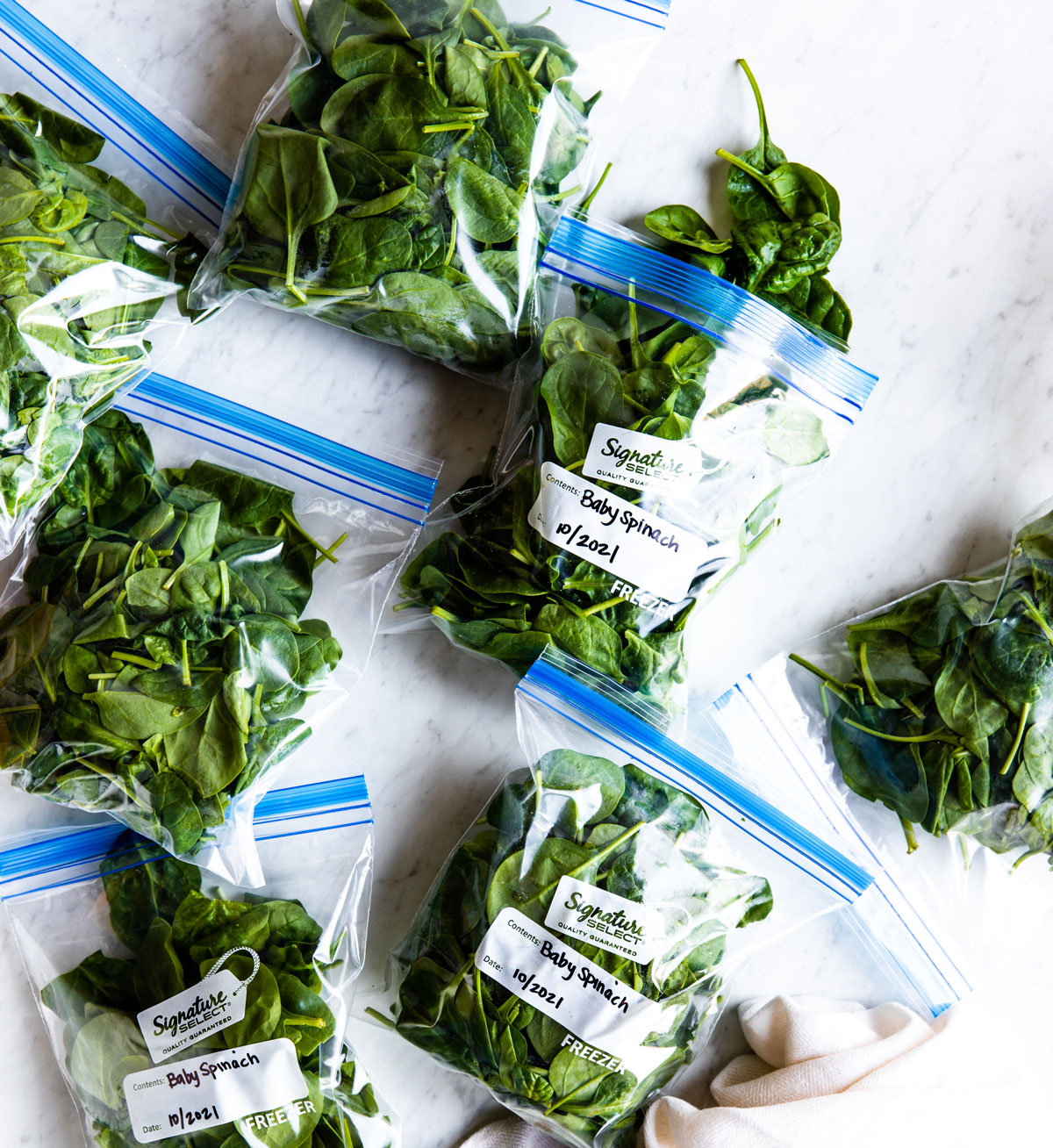
Freezing Your Leafy Greens
Ever wonder how to use up all the beautiful leafy greens you just bought, before they start to wilt? Even though I make green smoothies daily, I sometimes need to freeze my spinach or kale to stay fresh longer.
To lengthen the shelf life of leafy greens and make rotating your greens as easy as opening your freezer, try freezing your spinach. I buy spinach and power greens at Costco— freezing half of it maximizes the freshness.
Common Questions
You’ve probably heard of spinach, kale and lettuce, but leafy greens also include carrot tops, beet greens, swiss chard, arugula and more! They can grow all on their own, or be found on the tops of other plants (like broccoli, beets and carrots).
All leafy greens are incredibly nutritious and great to mix into your diet. Kale and spinach are probably the most nutrient-dense, yet you need a variety of greens (and other fruits and vegetables) for the best health. Don’t be afraid to give a new one a try next time you’re at the store. You might be surprised by mustard greens, bok choy and more!
Greens don’t just take place in salads or garnishes for burgers. You can use them in green smoothies, all kinds of pesto, filling for stuffed mushrooms or potatoes. Pretty much anything you want! Next time you are grocery shopping, grab a new-to-you leafy green and get adventurous with how you prepare it.
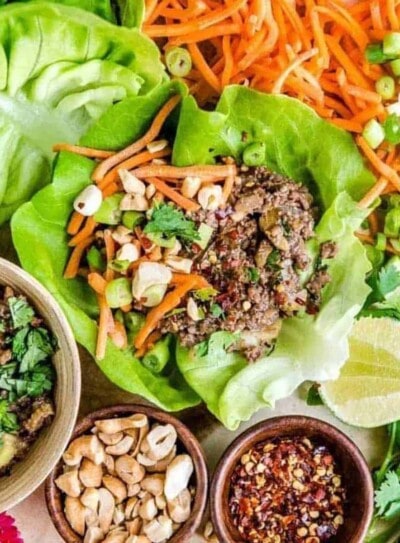
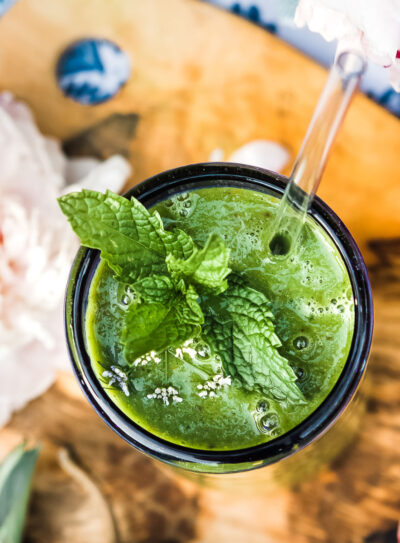
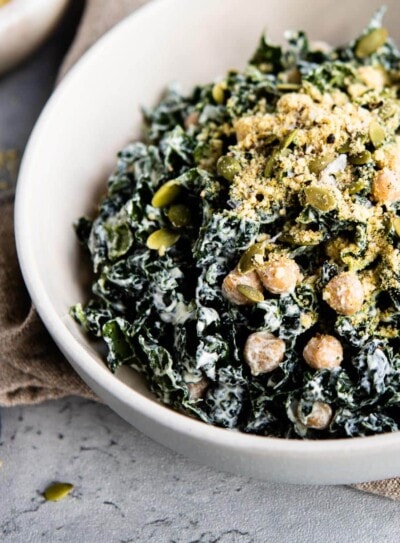
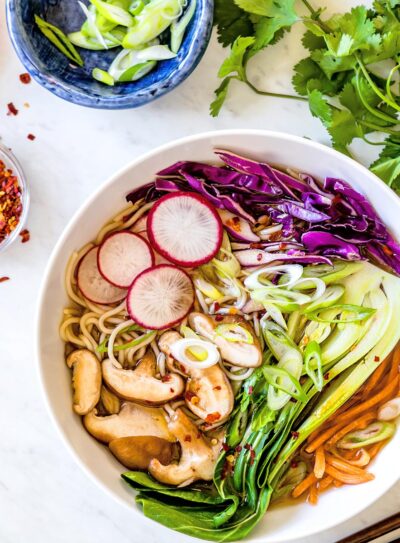
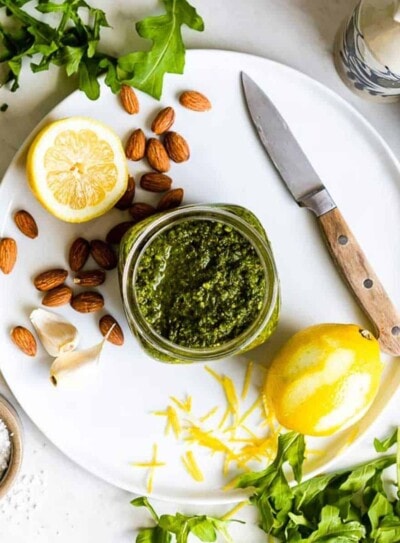
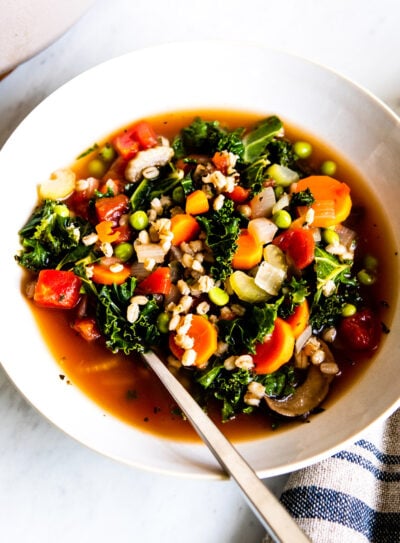
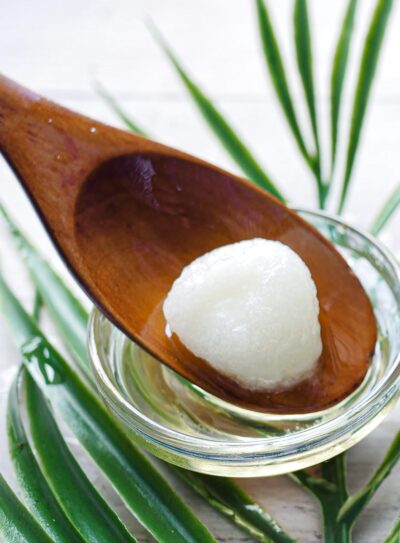




For those concerned about the effect of cruciferous veggies on thyroid…
Short answer: get enough iodine and you shouldn’t have any problem.
Hello Simple Green Smoothies,
some greens are not “mild” like kale or spinach, but a little … don’t know the word… (sharp/harsh/acrid/…?).
It just happened yesterday… It is a flavor that I experienced from adding perhaps too much of the stem of bok choi? Or perhaps the green of turnip cabbage or savoy cabbage or others. Or batavia lettuce? Or too much romaine lettuce? I’m a bit lost…
Question: Which ingredient counter-balances that?
Question: Which greens can be used in “cup-fuls” like kale and spinach, which should only be added in smaller amounts due to their strong taste?
Idea: Perhaps you could help a little and put the greens in two categories “main-green” vs. “side-green” (like main and side dish).
Or you add a little advice such as green x leads to flavor y and is best combined with type z fruits (e.g. citrus fruits // berries // bananas // …)
As they seem to delist frozen kale during summer and fresh kale is only rarely available, I need new “main greens”… and some of my own attempts to substitute your greens in your recipes went … ahem… not so well.
Thanks
Best regards
Birte
This is probably the most helpful:
Some people have a “bitter gene” that makes certain vegetable taste bitter to them. Try baby leaves, and try different kinds of leaves to find some that suit your taste. I personally find that red-leaved varieties usually taste less bitter. Remember to disguise your greens with lots of sweet fruit and ensure it’s blended thoroughly in a high quality blender 😀
Thanks, Vicky!
Yes, harvest time for baby leaves is coming up (if I keep finding the slugs before they find my baby leaves…). Problem solved 😉
Bitter (as in endive, dandelion,…) is fine with me, it’s more the fiercness (a very specific acridity) of cabbage I don’t like that much in a smoothie.
(I like nibbling raw turnip and other cabbages and I find that taste very good then)
I must say it is more a problem of “winter/spring smoothies” – I try to buy regional and seasonal and the variety of green leaves in winter is basically down to lamb’s lettuce and cabbage.
Hi there, thanks for the clear explanation of rotating the greens. I’m used to take my green smoothie every morning, but I’m really stuck on one favorite smoothie. Spinach, banana, some peanut butter, cacao and almond milk. I always use deep frozen spinach. Here in the Netherlands we have deep frozen spinach in little cubes, so it’s easy to throw 3 or 4 cubes of spinach into my smoothie. Makes my smoothie cool and fresh. But I’m not sure if it’s o.k. to use deep frozen vegetables?
Should be fine, Conny! Fresh is always best, but frozen is good, too.
Hi – This is a really helpful guide to the various families of leafy greens, and thank you for compiling it for us! I am wondering about the calcium content of dandelion greens… You list that a “healthy dose” contains almost as much calcium as a serving of cow’s milk, yet one cup raw of this green has only 10 percent of avg daily calcium needs… which is still a nice amount, but only a third of that in milk. Did you mean that a healthy dose would be three cups of dandelion greens?? Or was the amount of calcium you listed taking into account the bioavailability factor? Thank you!
Also I wanted to say that sometimes frozen veggies are actually fresher than “fresh” greens in the supermarket, which you cannot be certain as to how long they’ve been sitting there… Sometimes I go to buy greens and none of the bunches look as healthy as I’d like, a bit wilted. But usually when greens and other veggies are frozen and packaged for consumption, they are “flash frozen” which does preserve the nutrients very effectively! They also tend to be a bit more economical for those of us for whom that might be more of a concern.
Hi Rebecca!
We suggest using at least two cups of leafy greens in each smoothie, which would make it close to the calcium content in dairy milk. Hope this helps!
Rebecca – cows milk takes out more calcium from your body than it puts in, because your body has to strip calcium from your bones to neutralise the phosphorus and sulphur in the milk. This is why countries with the highest milk consumption have the highest levels of osteoporosis. The dairy industry propagandizes milk is being high in calcium for sales purposes. It is an easy sell, because milk and dairy are white or yellow like teeth and bones, so it is easy to form associations in people’s minds. Most people don’t even realise that calcium is a grey shiny metal.
Many leaves including dandelion greens have much more calcium than milk per 100 grams, but one cup of dandelion greens is probably only about 30 or 40 grams whereas one cup of milk is about 200 millilitres. Officially, to count as one of your portions of fruit or veg you need to eat 80 grams.
Cruciferous vegetables are higher in calcium than dandelion leaves though.
Yes, it is ok!
I always have kilos of that organic, frozen spinach (in cubes) in my freezer. My understanding is that its vitamin level is even better, as they directly process it after harvesting it.
And unfortunately most greens pretty quickly lose their vitamin levels.
(But some stuff even grows on a balcony/in a small garden!)
Maybe the German cubes are smaller, but I guess I use at least 15-25 cubes per (2-pers.) serving 😉 maybe I need to count again…
Best regards
Birte
PS: But 2 cups (as in the recipes) really almost equals 1 pack of frozen spinach (450 or 500 g). It really is a lot!
Do you have any thoughts on possibly adding edible seaweed to a smoothie? I’m trying to figure out a methodology for nori. Maybe soak and then blend? Any ideas?
Here’s some of our favorite things to add:
https://simplegreensmoothies.com/superfoods-list
Haven’t tried seaweed, though!
This is great news. I’d like to know if you could still use a mixture of beetroots and carrots as the vegetable? Just a thought because you haven’t mentioned them anywhere.
Sure, Christine! Check out this page!
https://simplegreensmoothies.com/fruit-and-vegetable-smoothie
Do you peel cucumbers?
You don’t need to!
This is such GREAT information ladies! Thank you so much for taking the time to put this together…very clear and concise! I will DEFINETLY be rotating my greens!
Great Jadah & Jen …. on the whole level just great !
and, i drink about one liter of a smoothie during the morning and its energy lasts for hours. sometimes it takes till two or sometimes even four o’clock p.m., till i am hungry again. i dont know if that is maybe too unilatterally and should i perhaps drink less smoothie and eat some more different things during a day ?i am not quiet sure. and i am not really going vegan or raw. i love salats, yes, which i use to eat at late afternoon. but i like cooked food once in a while, as i love to go to the pizzeria with friends sometimes and once a day i do drink coffee too, not with cowmilk, but other like almond or haver. but my question ….. if you only drink one smoothie in the morning, do you have something else for breakfast also ? and what do you eat during the rest of the day ? and do you do sports once a day or once per week, or something ? i am really curious about that. thank you so much and keep the good spirits up ! xxxx
Hi Dina!
We recommend drinking about 16-20 ounces for breakfast, and not eating anything else with it. It would be totally fine to workout, play sports, or anything active with just having a green smoothie for breakfast. They are packed with nutrition that will fuel your body!
Hello, i signed for the live 30 Day Challenge that starts in April, but i am starting with some of the recipes you have. I live in the Dominican Republic and kale is not that easy to find. When the challenge starts and i don’t have Kale, can i use another green? I bought baby spinach and that is what i am putting on my smoothies.
Sounds like Ces has some great options for you Gisselle! You can use any of the leafy greens above in any smoothie, too!
I’m in Mexico, and I have had Kale for the first time ever just last week (they just started selling it at the local supermarket a couple weeks ago). I’m taking a guess but “La Española” island 🙂 is quite warm, so greens like Kale or chard do not grow (they turn bitter if exposed to warm temperatures). But I believe you can find cabbage, celery, beets (for the tops), or lettuce? You can use all of them!
I have an underactive thyroid and my nutritionist said to cook any cruciferous vegetables to get rid of the goitergens. She that with a thyroid issue if you eat too many raw cruciferous vegetables you risk getting a goiter. When I use greens like spinach, kale, collard, greens, etc. I usually steam them a little. Do you think this has an effect on the smoothies?
Hi Natalie!
It definitely takes out some of the nutrition, but please follow your nutritionist’s orders!
Natalie, I have found out that when I eat too much it sends me into hypothyroidism. Hate that because I love spinach kale and arugula. I have also read that this can happen if your iodine levels are low. Have you heard that? I asked my doctor but he thought I was crazy. he put me on thyroid meds. I did not take them. I just changed what i ate. Now I went back three months later and he said the meds are working. I laughed and told him no I just changed my diet.
Hi! I’m venturing to assume that, when you use greens for your smoothies, you use the stems (if they are not de-stemmed as it happens when you buy spinach or chopped kale by the bag). When you use greens with thick, fibrous stems like Celery or Bok Choy, do you chop the stalk and count it towards the cup, or how do you measure it?
Hi Ces! For celery and bok choy, we just trim a small piece off the end if it’s dry at all and for the other greens, if it has a thick stem (like that of fresh kale not already pre-chopped, we cut that out and just use the leafy green part. And we measure the entire thing. 🙂
Hi I’ve been interested in the idea of the Green Smoothie Challenge for a while now but I’m still in the process of researching more about it. So, this might be a ignorant question but could asparagus be used as one of the greens in the smoothie?
Hi Katelyn!
We like to use one leafy green per green smoothie, and the rest is filled with fruit/vegetables. Asparagus would be one of those vegetables, but not technically a leafy green. We’ve never made a recipe with asparagus, though!
Hello I have a 8 and a 5 year old whom are starting to like the smothies I make at home. I want to know is it “kid friendly” and if so is there any recipes you might have for them to sip on. Thanks for your help!!
Hi Adriana! It sure is kid-friendly 🙂 If you go to our recipe page, you should see a button near the top that says “kid-friendly,” and it will give you some great options!
https://simplegreensmoothies.com/recipes
I have a question about cruciferous veggies and the thyroid. Should you avoid raw cruciferous veggies and greens if you have a thyroid condition?
Hi Deb,
We definitely recommend talking to your health care provider to see if raw veggies will hurt if you have a medical condition.
🙂
I just posted about this above a few. If I have too much it sends me into hypothyroidism
Hi! My husband and I have literally just started the green smoothie thing yesterday! It wasn’t as bad as we though thank goodness, we found its a huge mental thing rather than taste. My question is we are only using spinach at the moment for our green, and I must admit quite nervous to try other green, any recommendations for a beginner who is at this stage only having spinach, what would a good next step be in terms of a new green to add in the mix?
Thanks!
I use spinach almost exclusively, but I also use romaine and bok choy rather than kale because, though I have a good blender, I still can sense the weird texture of kale. Cilantro and celery are strong, but if you like them, go for it. Cabbage isn’t too strong, so you may want to try that, too.
Try lambs lettuce, also known as “corn salad” – it’s tastes exactly like spinach but is in a different family. Also, try rocket, also known as arugula, but be sure to choose the “salad” or “cultivated” variety rather than the “wild” sort, which is incredibly peppery and should be used as a herb, not a salad leaf. (It’s also not actually wild, that’s just what it’s called). Also, try generic salad leaves, they are often polycress or some related green.
Thanks! I’ve started using bok choy and romaine instead of kale because I don’t like the texture of kale. But spinach is my favorite! Can’t believe how many greens I get per day!
Isn’t it crazy how many greens are out there? So good for you!